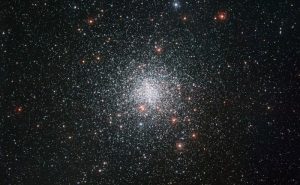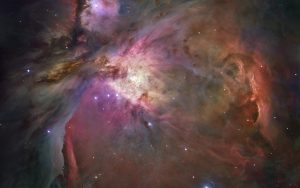(Note: This blog post is the second of two posts because the subject of the objects in Messier’s catalog turned out to require a wide ranging and lengthy discussion. This is Part 2; Part 1 was published on 21 July 2018.)
In my last post I mentioned how a good night of star gazing had inspired me to write about the French astronomer Charles Messier and his catalog of 110 fuzzy objects that you can see in the night sky with binoculars or a small telescope. I mentioned how these fuzzy objects, and others like them, are now the subjects of intense study by astronomers.
I mentioned further how the Messier objects can be broadly divided into six types before I began discussing at some length three of those types, Open Star Clusters, Globular Star Clusters and Gaseous Nebula. In this post I will complete my survey by describing the remaining three types, Planetary Nebula, Supernova Remnants and finally Galaxies.
Planetary Nebula (M57 the Ring Nebula): The best known planetary nebula is the famous Ring Nebula, M57 in the constellation of Lyra. See image below. To find the Ring Nebula first find the brilliant star Vega, the third brightest star visible in the northern hemisphere and the brightest star in Lyra. The second brightest star in Lyra (β Lyra) is about a fist’s distance to the south of Vega and the Ring Nebula is near β Lyra. Be warned however, the ring nebula can be quite difficult to spot, which of course is another way of saying I often have difficulty finding it.

Planetary nebulas are so named because about two hundred years ago the French Mathematician Pierre-Simon Laplace hypothesized that planetary systems, like our own Solar System, formed from a disk of material around a new star. (See my blog Post of 5July2018)
Several of the objects in Charles Messier’s catalog seemed to resemble the disks of material Laplace talked about and so they were christened ‘Planetary Nebula’. Unfortunately we now know that planetary nebula are actually dying stars, stars who have used up all of their initial hydrogen fuel and who have begun burning helium. At this stage in a star’s life it puffs up to many times its previous size and begins expelling much of its outer material. It is this expelled material that forms the disk observed as the planetary nebula.
About five or six billion years from now our own Sun will become an object very much like the Ring Nebula. It will, over the course of several hundred million years expel about half of its mass back into interstellar space leaving behind only an intensely hot but nevertheless dead core known as a white dwarf star.
Supernova Remnants (M1 The Crab Nebula): To find the Crab Nebula you need to find the horns of Taurus the bull. The Crab Nebula sits between the points of the two horns, closer to and below the horn on the left. Again the Crab Nebula is not easy to spot but you can find many images of it on the web, such as the one below.

Not all stars die as slowly and quietly as did the star that formed the Ring Nebula. Large, heavy stars that are more than five times the mass of our own Sun are fated to end their lives as Supernovas, massive explosions that can briefly increase a star’s brilliance hundreds of billions of times. The material flung outward by the force of the supernova will become a type of nebula known as a supernova remnant.
The famous Crab Nebula in the constellation of Taurus is one of these. The supernova that gave birth to the Crab Nebula was actually observed and recorded by Chinese astronomers way back in the year 1054 C.E. Today we know that what remains of the actual star that went nova is an incredibly dense neutron star, spinning on its axis thousands of time a second spewing out radio waves in pulses making it an object known as a Pulsar. If you’d like to hear the actual radio emissions from the pulsar at the heart of the Crab nebula click on the link below to be taken to Jodrell Bank Radio Observatory’s web page of pulsar transmissions. (The Crab Nebula is the sixth one down but Pulsar Number 1 is actually a better one to listen to!)
http://www.jb.man.ac.uk/pulsar/Education/Sounds/
Galaxies (M31: The Andromeda Galaxy): So far all of the objects in Messier’s catalog that I’ve described have been members of our own galactic neighborhood. The final type of Messier objects are other galaxies of which the most famous is the Andromeda Galaxy. Andromeda is a naked eye visible object; indeed at some two million light years distance it is the farthest object that can be seen with the naked eye. The image below shows what Andromeda looks like through a powerful telescope.

To see the Galaxy without binoculars or a telescope however you’re going to have to find REALLY dark skies because it is just a very faint smudge of light. The Galaxy itself is just off of the knee of the constellation Andromeda.
If you do succeed in finding the Andromeda Galaxy it is worth considering that that small smudge contains thousands of each of the other types of objects we’ve been talking about. It was of course the astronomer Carl Hubble who first measured the distance to Andromeda proving that it is indeed another galaxy every bit as large as our own Milky Way. By the way, the word galaxy is just Greek for Milky Way.
As I mentioned in the first part of this post, much of what we now know about the Universe comes from studying all of these objects that Charles Messier cataloged so that he wouldn’t mistake them for the comets he was searching for.
I was inspired to write this article by a very good night of stargazing during which I managed to find and spend some time studying seven of Messier’s objects. It turned out that I also managed to spot the International Space Station as it flew over New Jersey, and it was followed the Cygnus unmanned resupply module as well so I got a good look at both of them!
I’ve seen the space station dozens of times now along with NASA’s space shuttle and the Soyuz space capsule. The station itself is easy to find if you know when and where in the sky it will appear for your particular location.
Hey, ya know, that might be a good idea for another post!





